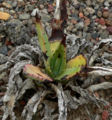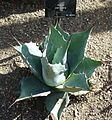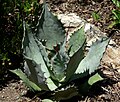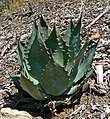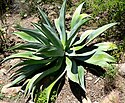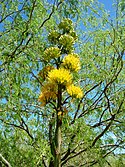Agave
| Agave | |
|---|---|
(c) Stan Shebs, CC BY-SA 3.0 Agave vilmoriniana. | |
| Videnskabelig klassifikation | |
| Rige | Plantae (Planter) |
| Division | Magnoliophyta (Dækfrøede) |
| Klasse | Liliopsida (Enkimbladede) |
| Orden | Asparagales (Asparges-ordenen) |
| Familie | Agavaceae (Agave-familien) |
| Slægt | Agave |
| Hjælp til læsning af taksobokse | |
Agave er en slægt af planter, der er udbredt i Caribien, Mexico og det sydvestlige USA. Agaveslægten rummer 221 arter, hvoraf kun et fåtal er i kultur som prydplante og endnu færre har et dansk navn. En del af dem bliver dog brugt som stueplanter i Danmark. Slægtsnavnet betyder fremragende eller storslået. Planterne er flerårige, urteagtige planter uden eller med en ganske kort overjordisk stængel. Bladene er samlet i tætte rosetter, hvori de enkelte blade er kødfulde til læderagtige, spidse og som regel med tornet rand. Planterne vokser i tropiske og subtropiske, tørre områder og er ofte sukkulente eller indeholder meget styrkevæv i bladene, så de ikke falder sammen under tørkeforhold. De store amerikanske agaver kaldes for "century plants" eller "Texas asparges" i deres hjemland. Det antyder, at der måske går 100 år før de blomstrer, det er måske lidt overdrevet, men det tager mange år. Når de blomstrer, dør de til gengæld efterfølgende.
| Arter |
- Agave attenuata
- Agave ghiesbreghti
- Agave lophantha
- Agave parviflora
- Almindelig agave (Agave americana)
- Arizonaagave (Agave arizonica)
- Dronning Victoria-agave (Agave victoriae-reginae)
- Sisalagave (Agave sisalana)
- Trådagave (Agave filifera)
Galleri
Agave bovicornuta
- (c) Stan Shebs, CC BY-SA 3.0
Agave bracteosa
- (c) Stan Shebs, CC BY-SA 3.0
Agave colorata
- (c) Stan Shebs, CC BY-SA 3.0
Agave deserti
- (c) Stan Shebs, CC BY-SA 3.0
Agave desmettiana
- (c) Stan Shebs, CC BY-SA 3.0
Agave filifera
- (c) Stan Shebs, CC BY-SA 3.0
Agave flexispina
- (c) Stan Shebs, CC BY-SA 3.0
Agave gentryi
- (c) Stan Shebs, CC BY-SA 3.0
Agave guadalajarana
- (c) Stan Shebs, CC BY-SA 3.0
Agave inaequidens
- (c) Stan Shebs, CC BY-SA 3.0
Agave karwinskii
- (c) Stan Shebs, CC BY-SA 3.0
Agave macroacantha
- (c) Stan Shebs, CC BY-SA 3.0
Agave mckelveyana
- (c) Stan Shebs, CC BY-SA 3.0
Agave missionum
- (c) Stan Shebs, CC BY-SA 3.0
Agave obscura
- (c) Stan Shebs, CC BY-SA 3.0
Agave ocahui
- (c) Stan Shebs, CC BY-SA 3.0
Agave ornithobroma
- (c) Stan Shebs, CC BY-SA 3.0
Agave pachycentra
- (c) Stan Shebs, CC BY-SA 3.0
Agave pacifica
- (c) Stan Shebs, CC BY-SA 3.0
Agave palmeri
- (c) I, KENPEI, CC BY-SA 3.0
Agave parviflora
- (c) Stan Shebs, CC BY-SA 3.0
Agave polianthiflora
- (c) Stan Shebs, CC BY-SA 3.0
Agave salmiana
- (c) Stan Shebs, CC BY-SA 3.0
Agave sebastiana
- (c) Stan Shebs, CC BY-SA 3.0
Agave shawii
- (c) Stan Shebs, CC BY-SA 3.0
Agave shrevei
- (c) Stan Shebs, CC BY-SA 3.0
Agave tequilana
- (c) Stan Shebs, CC BY-SA 3.0
Agave toumeyana
- (c) Stan Shebs, CC BY-SA 3.0
Agave utahensis
- (c) Stan Shebs, CC BY-SA 3.0
Agave vilmoriniana
- (c) Stan Shebs, CC BY-SA 3.0
Agave wercklei
- (c) Stan Shebs, CC BY-SA 3.0
Agave wocomahi
- (c) Stan Shebs, CC BY-SA 3.0
Agave xylonacantha
- (c) Stan Shebs, CC BY-SA 3.0
Agave ×arizonica
- Anvendelse
Om sommeren kan de udmærket stå ude, ja i mange år helt til november, for de tåler en smule frost. Opbevares inden døre, tørt, køligt og lyst vinteren over. Nem formering ved sideskud, der fremkommer i stor mængde. De store planter kræver megen plads, og man skal helst ikke komme dem for nær. Hvis tornene på bladspidserne knækker, bliver bladene brune og kedelige at se på. Nogle af arterne bruges i Mexico til at lave Tequila og taverne af andre bruges til bast og tovværk (sisal).
| Wikimedia Commons har medier relateret til: |
|
Medier brugt på denne side
(c) Stan Shebs, CC BY-SA 3.0
Agave colorata at the University of California Botanical Garden, Berkeley, California
(c) Stan Shebs, CC BY-SA 3.0
Agave xylonacantha at the University of California Botanical Garden, Berkeley, California
(c) Stan Shebs, CC BY-SA 3.0
Agave wocomahi at the University of California Botanical Garden, Berkeley, California
(c) Stan Shebs, CC BY-SA 3.0
Photo of Agave falcata var. espadina at the University of California Botanical Garden
(c) Stan Shebs, CC BY-SA 3.0
Photo of Agave ocahui at the University of California Botanical Garden
Forfatter/Opretter: Frank Vincentz, Licens: CC BY-SA 3.0
Agave attenuata growing in Barlovento, La Palma, Canary Islands
(c) Stan Shebs, CC BY-SA 3.0
Agave wercklei at the University of California Botanical Garden, Berkeley, California
(c) Stan Shebs, CC BY-SA 3.0
Agave polyacantha at the University of California Botanical Garden, Berkeley, California
Forfatter/Opretter: Montrealais, Licens: CC BY 3.0
Agave guiengola, Jardin Botanique de Montréal
(c) Stan Shebs, CC BY-SA 3.0
Photo of Agave ferox at the San Francisco Botanical Garden
(c) Stan Shebs, CC BY-SA 3.0
Photo of Agave inaequidens ssp. barrancensis at the Living Desert in Palm Desert, California
(c) Stan Shebs, CC BY-SA 3.0
Photo of Agave toumeyana var. bella at the University of California Botanical Garden
(c) Stan Shebs, CC BY-SA 3.0
Agave macroacantha at the University of California Botanical Garden, Berkeley, California
(c) Stan Shebs, CC BY-SA 3.0
Agave shrevei subsp. shrevei at the University of California Botanical Garden, Berkeley, California
(c) Stan Shebs, CC BY-SA 3.0
Agave desmettiana at the University of California Botanical Garden, Berkeley, California
(c) Stan Shebs, CC BY-SA 3.0
Agave sebastiana at the University of California Botanical Garden, Berkeley, California
(c) Stan Shebs, CC BY-SA 3.0
Photo of Agave tequilana t at Dona Engracia hacienda, Jalisco, Mexico
Agave salmiana at Kew Gardens, London, England, very roughly 3 feet (1 metre) high.
The tubes are glass sculptures (part of an exhibition).
(c) Stan Shebs, CC BY-SA 3.0
Photo of Agave shawii at Regional Parks Botanic Garden
Forfatter/Opretter: Miwasatoshi, Licens: CC BY-SA 4.0
Agave chrysantha, cultivated, Desert Botanical Garden, Phoenix, Arizona
(c) Stan Shebs, CC BY-SA 3.0
Agave ornithobroma at the University of California Botanical Garden, Berkeley, California
(c) Stan Shebs, CC BY-SA 3.0
Photo of Agave bracteosa (spider agave) at the Desert Demonstration Garden in Las Vegas, Nevada
(c) Stan Shebs, CC BY-SA 3.0
Agave filifera at the University of California Botanical Garden, Berkeley, California
Forfatter/Opretter: Alberto Salguero, Licens: CC BY-SA 3.0
Maguey manso o pulquero (Agave salmiana)
Forfatter/Opretter: Kurt Stüber [1], Licens: CC BY-SA 3.0
Species: Agave lechuguilla
Family: Agavaceae
Forfatter/Opretter: Digigalos, Licens: CC BY-SA 3.0
Agave murpheyi. Foto tomada en el Real Jardín Botánico de Madrid.
(c) Stan Shebs, CC BY-SA 3.0
Photo of Agave missionum at the University of California Botanical Garden
(c) Stan Shebs, CC BY-SA 3.0
Photo of Agave vilmoriniana (octopus agave) at the Desert Demonstration Garden in Las Vegas
(c) Stan Shebs, CC BY-SA 3.0
Photo of Agave gentryi at the University of California Botanical Garden
(c) Stan Shebs, CC BY-SA 3.0
Agave karwinskii at the University of California Botanical Garden, Berkeley, California
(c) Stan Shebs, CC BY-SA 3.0
Agave pacifica at the University of California Botanical Garden, Berkeley, California
(c) Stan Shebs, CC BY-SA 3.0
Photo of Agave vilmoriniana (octopus agave) at the Desert Demonstration Garden in Las Vegas
© Derek Ramsey / derekramsey.com, GFDL 1.2
A top view picture of the Agave bovicornuta en plant. Photo taken at the Chanticleer Garden where it was identified.
| |||
(c) Stan Shebs, CC BY-SA 3.0
Agave polianthiflora — endemic to northern Mexico.
- Specimen in the University of California Botanical Garden, Berkeley, California.























